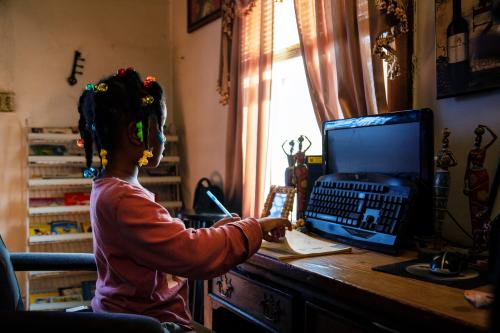This opinion piece originally appeared in The Hill.
The term “digital divide” has moved into the mainstream, as the pandemic revealed how unforgiving life can be for those disconnected from the internet. As Americans have been forced to work, learn, and socialize from home, many in rural and low-income communities have found getting and staying online a major challenge.
At $65 billion, broadband funding from the now enacted Infrastructure Investment and Jobs Act (IIJA), will be the largest-ever digital infrastructure investment and the first since the 2009 American Recovery and Reinvestment Act (ARRA), which allocated $4.7 billion to close the digital divide.
The National Telecommunications and Information Administration (NTIA) will play the biggest role in the distribution of these funds, allocating $48.2 billion of the $65 billion to states for broadband deployment and adoption. Poised to distribute the largest pot of money to expand affordable, high-speed broadband access and digital inclusion programs, policymakers and even some advocacy groups must first focus on defining the problem and expected outcomes in order for this to work.
The digital divide dates to the early 2000s, when former NTIA Assistant Secretary Larry Irving called out the concept, offering a then-binary view into disparate access to technology. The digital divide depicted those with and without access to the internet, a compatible device, or both. Back then, digital literacy programs were critical because some policymakers and advocates believed that poor people needed computer basics, like how to use email and word processing programs.
Today, the need for computer skills and access has grown exponentially, changing how individuals interact. Yet politicians have still failed to bridge the digital divide, having previously expended resources on program models that have not necessarily scaled or sustained digital inclusion before the pandemic. Even with IIJA funds, the federal government will once again fail to address digital disparities without a clear definition of the problems being solved and a lack of substantive feedback from local stakeholders who understand the conditions of their communities.
Part of this failure rests on the reliance of policymakers on regulatory guidance from communications policies drafted before the contemporary internet, and their sole focus on accelerating broadband access instead of economic mobility and social justice for the digitally disenfranchised. If prior policies worked well to close the digital divide, we would not be racing to the bottom to ensure equitable access. Getting people connected to affordable broadband and a device are only partial solutions to narrowing the digital divide. We often forget that people still need the required financial collateral like a bank or credit card to take advantage of now-digitized services like ridesharing and e-commerce.
Which brings me to this: The severity of the digital divide goes beyond the usual analogy of a three-legged stool — broadband availability, affordability, and digital literacy. Policymakers must acknowledge that efforts to close the digital divide should also address poverty, geographic, and social isolation.
Put simply, people not online still face systemic societal inequalities, only this time within new systems and applications like telehealth, online vaccination scheduling, or online job applications. All while still relegated to second-class, digital citizenship. These are points that I make in my forthcoming book, “Digitally Invisible: How the internet is creating the new underclass” (Brookings Press, 2022), which draws upon the experiences of everyday people, from farmers to students of color, already neglected by our nation before the pandemic further devastated their households, businesses, and communities.
If their voices are not included before federal support is released, bureaucrats will turn to familiar paradigms about the digital divide that bypass the role of technology in confronting larger social inequalities. That is why federal and state governments must deliver a “hand up” rather than a paternalistic “hand out” to mitigate digital disparities. Government agencies, alongside anchor institutions and community partners, must work toward the institutionalization and intuitive familiarity of digital use within urban and rural communities.
The next few months should not be a rush to play catch up for the millions of left-behind Americans. Instead, the U.S. should be focused on moving people and their communities from consumers to producers and innovators who are prepared to accelerate our global, digital competitiveness.
But doing so requires a clearer definition of the digital divide, avoiding the over-emphasis on a device and a home broadband connection.
National efforts must bring new and diverse voices to the table who understand that being connected can bridge the economic and social divides faced by their residents and local constituents. Otherwise, we will have squandered the best opportunity in decades to close the digital divide.
The Brookings Institution is committed to quality, independence, and impact.
We are supported by a diverse array of funders. In line with our values and policies, each Brookings publication represents the sole views of its author(s).






Commentary
Can we better define what we mean by closing the digital divide?
January 11, 2022